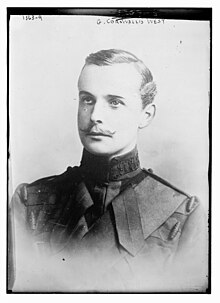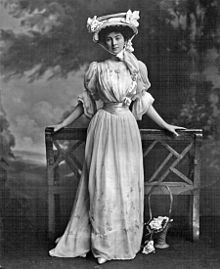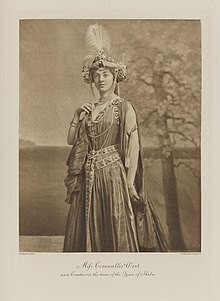Social Victorians/People/Cornwallis-West
Also Known As
[edit | edit source]- Family name: Cornwallis-West
- Shelagh (Constance) Cornwallis-West
- Constance, Duchess of Westminster
Acquaintances, Friends and Enemies
[edit | edit source]Timeline
[edit | edit source]1897 July 2, Friday, George Cornwallis-West, Miss West (Shelagh Cornwallis-West) and Daisy, Princess of Pless attended the Duchess of Devonshire's fancy-dress ball at Devonshire House. (George Cornwallis-West is #706 in the list of people who were present; Shelagh Cornwallis-West is #227.)
1900 July 28, Jennie, Lady Randolph Churchill and George Cornwallis-West married.[1]
1901 February 16, Constance (Shelagh) Cornwallis-West and Hugh Grosvenor, 2nd Duke of Westminster married.[2]
1914 April 1, Jennie, Lady Randolph Churchill and George Cornwallis-West divorced.[3]
1914 April 6, George Cornwallis-West and Mrs. Patrick (Beatrice Stella Tanner) Campbell married.[3]
Costume at the Duchess of Devonshire's 2 July 1897 Fancy-dress Ball
[edit | edit source]Daisy, Princess of Pless and Henry, Prince of Pless
[edit | edit source]Daisy, Princess of Pless (at 38) and Henry (Heinrich), Prince of Pless (at 40) are treated on their own page.

George Cornwallis-West
[edit | edit source]George Cornwallis-West was in the entourage of his sister, Daisy, Princess Henry of Pless, as an attendant. In his memoir, he says,
Not having the wherewithal myself to pay for a fancy dress, I was pressed into her [Daisy, Princess Pless's] service, with the bribe of a free costume, as one of the entourage of her Court, whose dresses had been designed by a famous theatrical designer of the day. Why he should have insisted that the Queen of Sheba’s male attendants were full-blooded negroes and dressed in garments like multicoloured bed quilts I have no idea ... the fact remains that I hated blackening my face, and my girl friends did not in the least appreciate me in that disguise; consequently I didn’t enjoy myself in the slightest, and left early, with bitterness in my heart towards the theatrical designer.[4]:97
Attilio Comelli may have been the designer George Cornwallis-West is referring to in this reflection from his memoir.
The portrait of Cornwallis-West (right) was taken in 1900, 3 years after the ball.
George Cornwallis-West's portrait was not included among the portraits in the album given to the Duchess of Devonshire as a hostess gift, but he was photographed in costume — and Blackface — by Lafayette. The photograph can be seen in the Lafayette Archive here: "Black Slave."
Commentary on George Cornwallis-West's Costume
[edit | edit source]This commentary refers to the portrait in the Lafayette Archive. George Cornwallis-West is probably supposed to represent an African man.
- He probably had this portrait taken at the ball.
- The sophistication of the asymmetrical design is belied by the very simple construction and decoration. In fact, this costume looks so cheaply made that George Cornwallis-West looks like a servant, especially compared to the rich dress worn by his sister Shelagh Cornwallis-West, who was also in the Princess of Pless's entourage. His costume looks as if it was made for the stage rather than the ballroom:
- It was made to allow for free movement of the limbs.
- All the trim is stitched down.
- The embellishments are very simple compared to most of the other men's costumes.
- What the somewhat 3-dimensional trim is made of is not clear in photograph, whether embroidery, braid, beads, appliqué or the occasional jewel.
- His headdress is shaped like a cap or helmet, but it is made of metal bars that are rounded over the crown of the head, so it is not solid as a helmet would be. Parts of the helmet are decorated with jewels, with hanging ornaments perhaps suggesting big earrings.
- His own hair was very thin, light brown, and slightly wavy. His moustache would have been waxed and cared for. His wig is part of the Africanized costume.
- His skin appears to have been darkened with makeup.
- His necklace might be intended to represent a badge of office or honor like the ones worn by European monarchs or ministerial appointees. The necklace appears to be attached to the shoulders by brooches or stitching.
- This costume has two layers: a striped over-tunic and an under-tunic.
- Closure of the over-tunic is a long embroidered and jeweled panel down the left side. The over-tunic is decorated with the closure panel and another 3-dimensional, heavier-weight panel around the bottom. The line of the over-tunic is smooth and cylindrical — rather than draping softly — because of the straight cut, the borders on the stripes and and the heaviness of the bottom panel. Possibly this costume was quilted, as George Cornwallis-West suggested, which would also contribute to its smooth line.
- The under-tunic is longer than the over-tunic and has embroidered bands along the bottom and two bands on each sleeve. Except for the arms bands and band along the bottom, the under-tunic is very plain, with no decoration at all at the neck.
- His shoes are plain slippers worn over stockings.

Shelagh (Constance Edwina) Cornwallis-West
[edit | edit source]
Miss Cornwallis West or Miss West, sister of Daisy, Princess Henry of Pless, so Shelagh (Constance Edwina) Cornwallis-West, was among the Suite of Ladies in the Oriental procession.[5]:p. 7, Col. 5b [6] She's listed with Mary Goelet, Lady C. Grosvenor, Miss Oppenheim as members of that "suite."
Lafayette's portrait (left) of "Constance Edwina (née Cornwallis-West), Duchess of Westminster (later Mrs Lewis) as a Courtier in the train of the Queen of Sheba" in costume is photogravure #283 in the album presented to the Duchess of Devonshire and now in the National Portrait Gallery.[7] The printing on the portrait says, "Miss Cornwallis West as a Courtier in the train of the Queen of Sheba," with a Long S in Miss.[8]
This portrait of Shelagh Cornwallis-West is the only image extant of her in her costume; the Lafayette Archive has no more images of her in this costume. The sepia tone of all the portraits in the album is consistent with making it look old fashioned, like the use of the Long S in the letter press.
Lafayette's portrait (right) of Shelagh (Constance Edwina) Cornwallis-West was taken c. 1906.
Newspaper Accounts of Her Costume
[edit | edit source]She was Princess Henry's "Ethiopian attendant."[9]:p. 5, Col. 7c
- "Black attendants bore her [the Princess of Pless's] train along, and among her girl attendants was her pretty sister, Miss Cornwallis West, in an Ethiopian dress of snowy crêpe, gilded with jewels under a flowing robe of gold tissue. A drapery of gold and pink shot tissue was held round the hips by jewelled wings, and the pleated Liberty silk under-dress was hemmed with pink roses, repeating the flowers in the hair."[10]:42, Col. 1b
- Constance Cornwallis-West was "(attendant to the Queen of Sheba), [and wore an] Ethiopian dress of white crêpe, edged with pale pink roses; jewelled girdle, and bands of gold tissue; classic drapery of gold and pink shot tissue."[11]:p. 42, Col. 3a
Even though she was dressed as an "Ethiopian attendant," she does not in the portrait appear to have worn Black face as part of her costume. The newspaper accounts do not mention blackface either, or any alteration to her appearance except for her costume. If she wore blackface to the party, she does not seem to have worn it for her portrait, which could have been taken before or after the ball.
Commentary on Her Costume
[edit | edit source]The 2 newspaper accounts we have provide confusing and contradictory evidence for an analysis of this costume, which is a Victorian (not an African or Ethiopian) dress with some elements of the progressive style. The first account, from Truth, which was not a fashion or women's newspaper, purports to have been written by a girl gossiping with her friend about the dress. The Gentlewoman, however, the source of the 2nd account, is likely more trustworthy on details of clothing.
- Shelagh Cornwallis-West is wearing Victorian foundation garments. In fact, the edge of her corset shows at the bust and hips beneath the thin shot-silk fabric.
- The photograph does not permit us to distinguish one layer of this costume from another. Because of the way it is cropped, we cannot see the bottom edge of any of the layers of the costume or what shoes she is wearing. The newspaper accounts mention an edging of pink roses on the dress, but what kind of edging — whether attached, appliquéd or woven flowers — is impossible to say.
- The newspapers identify an underdress and drapery or a robe over it. The underdress was made of silk from Liberty's and, at least according to the 2 newspaper accounts we have, pleated and white, although the photograph does not make the dress appear to be white. The drapery or robe is also pleated and was made of shot silk tissue (gold and pink).
- This costume is interesting because of its pleating, almost as if it is a precursor to the much-more-finely-pleated 1907 Delphos gown. The gown was designed and constructed by the husband-and-wife team Mariano Fortuny y Madrazo and Henriette Negrin.[12]
- Jewels and gold cord decorate the belting that wraps around the waist and as well as around the hips. The design of the belting is repeated in the trim at the neck and around the arm holes. The belting emphasizing the narrow waist is part of the traditional Victorian style.
- She is wearing bracelets, rings and a jewelled and feathered headdress or crown. Ropes of pearls hang from the crown, her neck and her shoulders. The account from Truth says the flowers on her headdress are roses, but they look more like zinnias than roses.
Demographics
[edit | edit source]- Nationality: British[13]
Family
[edit | edit source]- William Cornwallis Cornwallis-West (20 March 1835 – 4 July 1917)[14]
- Patsy (Mary Adelaide Virginia Eupatoria) FitzPatrick Cornwallis-West (1856– July 1920)[15]
- Daisy (Mary Theresa) Cornwallis-West then Daisy, Princess of Pless or Princess Henry of Pless (28 June 1873 — 29 June 1943)[16]
- Major George Frederick Myddelton Cornwallis-West (14 November 1874 — 1 April 1951)
- Shelagh (Constance Edwina) Cornwallis-West (c. 1878 — 21 January 1970)
- George Frederick Myddelton Cornwallis-West (14 November 1874 — 1 April 1951)
- Jennie, Lady Randolph Churchill (9 January 1854 – 29 June 1921)[17]
- Mrs. Patrick (Beatrice Stella Tanner) Campbell (9 February 1865 – 9 April 1940)[18]
Biographical Materials
[edit | edit source]- The Irish Archives Resource has no documents or photographs findable by searching Cornwallis, Fitzpatrick or Ruthin (Col. Frederick Richard Cornwallis-West's castle in Denbighshire[19]) relevant to any of these people.
Notes and Questions
[edit | edit source]- George Cornwallis-West attended the Duchess of Devonshire's ball but he has almost no mentions in the papers, perhaps because he wore Black face, perhaps because he wanted to suppress notice of his presence. He didn't marry Jennie, Lady Randolph Churchill until 1900.
- Patsy Cornwallis-West was an intimate of Albert Edward, Prince of Wales.
- George Cornwallis-West married Mrs. Patrick Campbell, the actor who played Eliza in G. B. Shaw's Pygmalion, for example, in 1914.[20]
Footnotes
[edit | edit source]- ↑ "Jennie Jerome." "Person Page". www.thepeerage.com. Retrieved 2020-11-01.
- ↑ "Constance Lewis - Wikipedia". en.wikipedia.org. Retrieved 2024-04-03. https://en.wikipedia.org/wiki/Constance_Lewis.
- ↑ 3.0 3.1 "George Cornwallis-West". Wikipedia. 2021-09-07. https://en.wikipedia.org/w/index.php?title=George_Cornwallis-West&oldid=1042934380. https://en.wikipedia.org/wiki/George_Cornwallis-West.
- ↑ Qtd. in Martin Spies, ""Late Victorian Aristocrats and the Racial Other: The Devonshire House Ball of 1897." Race & Class April–June 2016 (57.4): 95–103.
- ↑ "Fancy Dress Ball at Devonshire House." Morning Post Saturday 3 July 1897: 7 [of 12], Col. 4a–8 Col. 2b. British Newspaper Archive https://www.britishnewspaperarchive.co.uk/viewer/bl/0000174/18970703/054/0007.
- ↑ "Ball at Devonshire House." The Times Saturday 3 July 1897: 12 [of 20], Cols. 1a–4c [of 6] The Times Digital Archive. Web. 28 Nov. 2015.
- ↑ "Devonshire House Fancy Dress Ball (1897): photogravures by Walker & Boutall after various photographers." 1899. National Portrait Gallery https://www.npg.org.uk/collections/search/portrait-list.php?set=515.
- ↑ "Miss Cornwallis West as a Courtier." Diamond Jubilee Fancy Dress Ball. National Portrait Gallery https://www.npg.org.uk/collections/search/portrait/mw86216/Constance-Edwina-ne-Cornwallis-West-Duchess-of-Westminster-later-Mrs-Lewis-as-a-Courtier-in-the-train-of-the-Queen-of-Sheba.
- ↑ "Duchess of Devonshire's Fancy Ball. A Brilliant Spectacle. Some of the Dresses." London Daily News Saturday 3 July 1897: 5 [of 10], Col. 6a–6, Col. 1b. British Newspaper Archive http://www.britishnewspaperarchive.co.uk/viewer/bl/0000051/18970703/024/0005 and http://www.britishnewspaperarchive.co.uk/viewer/BL/0000051/18970703/024/0006.
- ↑ “Girls’ Gossip.” Truth 8 July 1897, Thursday: 41 [of 70], Col. 1b – 42, Col. 2c. British Newspaper Archive https://www.britishnewspaperarchive.co.uk/viewer/BL/0002961/18970708/089/0041.
- ↑ “The Duchess of Devonshire’s Ball.” The Gentlewoman 10 July 1897 Saturday: 32–42 [of 76], Cols. 1a–3c [of 3]. British Newspaper Archive https://www.britishnewspaperarchive.co.uk/viewer/bl/0003340/18970710/155/0032.
- ↑ "Mariano Fortuny (designer)". Wikipedia. 2024-02-04. https://en.wikipedia.org/w/index.php?title=Mariano_Fortuny_(designer)&oldid=1203115199. https://en.wikipedia.org/wiki/Mariano_Fortuny_(designer).
- ↑ "William Cornwallis-West". Wikipedia. 2020-02-03. https://en.wikipedia.org/w/index.php?title=William_Cornwallis-West&oldid=938994066.
- ↑ "William Cornwallis Cornwallis-West." "Person Page". www.thepeerage.com. Retrieved 2020-10-05. https://www.thepeerage.com/p923.htm#i9230.
- ↑ "Mary Adelaide Virginia Eupatoria FitzPatrick." "Person Page". www.thepeerage.com. Retrieved 2021-11-08. https://www.thepeerage.com/p924.htm#i9231.
- ↑ "Mary Theresa Cornwallis-West." "Person Page". www.thepeerage.com. Retrieved 2021-11-08. https://www.thepeerage.com/p679.htm#i6786.
- ↑ "Jennie Jerome." "Person Page". www.thepeerage.com. Retrieved 2020-11-01.
- ↑ "Mrs Patrick Campbell". Wikipedia. 2021-11-12. https://en.wikipedia.org/w/index.php?title=Mrs_Patrick_Campbell&oldid=1054853007. https://en.wikipedia.org/wiki/Mrs_Patrick_Campbell.
- ↑ "Princess Henry of Pless at the Devonshire House Ball 1897, by Lafayette". lafayette.org.uk. Retrieved 2024-05-10. http://lafayette.org.uk/ple1597a.html.
- ↑ "Mrs Patrick Campbell". Wikipedia. 2024-03-20. https://en.wikipedia.org/w/index.php?title=Mrs_Patrick_Campbell&oldid=1214652426. https://en.wikipedia.org/wiki/Mrs_Patrick_Campbell.
